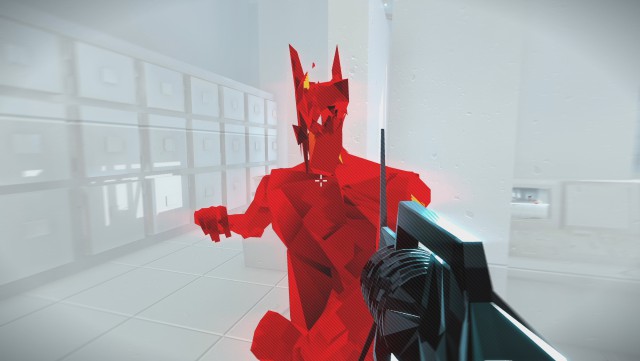
The Kitchen’s meat locker and the Prison’s guard station are easy to camp in, whereas the Disco and Dojo have dangerous wide-open spaces.

Fail a node, and your next run may pull an entirely different lineup out of its pool of over 30 maps, some of which are noticeably easier than others. Players wander through an ASCII map of interconnected nodes, each one containing somewhere from five to 10 levels, all of which must be completed within a set number of lives in order to progress. Mind Control Delete instead randomly generates most of its challenges. Though it’s an intentional choice, players may find themselves missing the deliberate encounters of the original Superhot, which featured pre-set scenarios to fight your way out of. You’ll also sometimes be faced with unkillable enemy archetypes like the charging Dog, katana-master Nindza, and position-swapping Addict, each one reflecting a toxic aspect of the gaming community such as avarice, addiction, or anger. And if you utilize the re, you can summon a thrown katana back into your hand, just like a Jedi.Įlsewhere, you’ll have to make use of new skills like ricocheting bullets and close-range invulnerability, because levels may now include explosive mines and spiky enemies that release shrapnel when hit. With the grenade.hack enabled, every once-innocuous item-be it a stapler or a billiard ball-now detonates when thrown. There are two new and improved endless modes, each of which can be tackled with a variety of superpowers and “hacks.” These abilities shake up the basic concept of Superhot, so while you’re still throwing objects or shooting guns at bright red enemies, carefully clearing a room of its foes, your options for doing so are broader. Though Mind Control Delete has clear intentions, it never resorts to cheap tricks to make players step back and realize that sometimes less is more. “There won’t be any closure,” we’re warned, “just more senseless killing.” There’s a fine line here between entertainment and annoyance, and the developers at SUPERHOT Team ride it like they’re playing the nerviest game of chicken, pushing players to the point at which the joy of pulling off that perfect sequence perhaps begins to sour. In-game, “MORE” is repeated as much as “SUPER HOT,” and so much so that the word practically loses all meaning, which is when you begin to see the way the game serves as a critique of itself. To this already volatile mix, there are now more levels, more abilities, more enemy types, more story. And not just more of those first-person fights where you step between slow-motion bullets to punch a shooter, grab his weapon and use it to pick off a sniper, hurl it at another foe, and then jump-punch your way to another enemy. “MORE,” it reads, and that’s what the game delivers. The blinking red box that greets you each time you boot up the game promises as much.


Mind Control Delete at first appears to exist for one reason: to deliver more Superhot. Whereas Superhot subversively riffed on the tenebrous nature of control, Mind Control Delete slyly questions the purpose of extra content and how long a game should or shouldn’t be. Superhot: Mind Control Delete, initially planned as DLC but now releasing as a standalone game that’s bigger than the original, is a brilliant rebuttal to that criticism. When Superhot was released in 2016, much praise was heaped on its novel “time moves when you move” gimmick, though some criticized the game for its brevity.


 0 kommentar(er)
0 kommentar(er)
